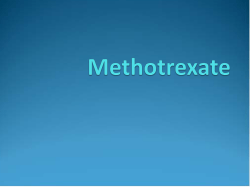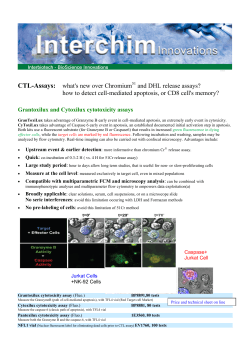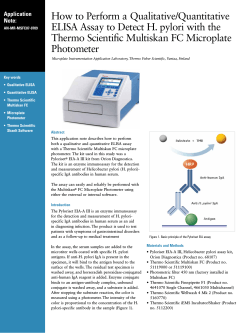
Biosimilars: Case studies on how to hit the target 25th Annual EuroMeeting
Biosimilars: Case studies on how to hit the target Joerg Windisch, Ph.D. Chief Science Officer Sandoz Biopharmaceuticals DIA EuroMeeting Amsterdam, March 6, 2013 25th Annual EuroMeeting 4-6 March 2013 RAI, Amsterdam Netherlands The views and opinions expressed in the following PowerPoint slides are those of the individual presenter and should not be attributed to Drug Information Association, Inc. (“DIA”), its directors, officers, employees, volunteers, members, chapters, councils, Special Interest Area Communities or affiliates, or any organization with which the presenter is employed or affiliated. These PowerPoint slides are the intellectual property of the individual presenter and are protected under the copyright laws of the United States of America and other countries. Used by permission. All rights reserved. Drug Information Association, DIA and DIA logo are registered trademarks or trademarks of Drug Information Association Inc. All other trademarks are the property of their respective owners. Drug Information Association www.diahome.org 2 Biosimilars must be systematically engineered to match the reference product 2. Target directed development Biological variability Clinical Recombinant cell line development PK/PD 3. Confirmation of biosimilarity Process development Bioprocess development Preclinical Purification process development Biological characterization Analytics Drug product development Physicochemical characterization Target range Reference product variability 1. Target definition Drug Information Association www.diahome.org 3 Structure: High resolution, orthogonality and redundancy in analytical characterization provide full understanding Attributes: Primary structure Mass Disulfide bridging Free cysteines Thioether bridging Higher order structure N- and C-terminal heterogeneity Glycosylation (isoforms, sialic acids, NGNA, fucosylation, alpha gal, site specific) Glycation Fragmentation Oxidation Deamidation Aggregation Drug Information Association Proteins can be well characterized at least up to the complexity of monoclonal antibodies Primary structure determined from recombinant DNA sequence and fully accessible to analytical verification Set of orthogonal analytical methods available to characterize the identity and amount of related variants with high sensitivity Glycosylation profile can be comprehensively determined with regard to identity and content of individual glycans with high sensitivity Accurate and relevant bioassays for pivotal biological functions available www.diahome.org Methods e.g.: MS (ESI, MALDITOF/TOF, MS/MS) Peptide mapping Ellman‘s CGE SDS-PAGE CD H-D exchange FT-IR HPLC HPAEC IEF 2AB NP-HPLC SE-HPLC FFF AUC DLS MALLS 4 Function: Broad range of sensitive biological, biophysical and immunological assays provides full understanding Attribute Functiona Assay l element Binding to target Fab Formats Binding assay Cellular binding assay Surface plasmon resonance (Biacore®) Programme Fab d cell death Apoptosis assay Cell based apoptosis assay CDC Fab and Fc CDC assay Cell based CDC assay Fc C1q binding Surface plasmon resonance (Biacore®) Fab and Fc ADCC assay Cell based ADCC assay Fc FcgR binding Surface plasmon resonance Fc FcRn binding Surface plasmon resonance ADCC PK Drug Information Association www.diahome.org 5 Understanding the target: Variability is significant in reference biologics – antibody example 2,0 Monitoring batches of an approved mAb revealed a shift in quality Post-Shift Unfucosylated G0 [% of glycans] 1,6 1,2 Pre-Shift Shift in glycosylation (structure) pattern results in different potency in cell-based assays (function) 0,8 0,4 0,0 08.2007 12.2008 05.2010 09.2011 Expiry Date 140 ADCC Potency [% of reference] Indication of a change in the manufacturing process Post-Shift 120 Schiestl, M. et al., Nature Biotechnology 29, 310-312, 2011) 100 80 Products found to be equally safe and effective post-shift by regulators (EMA, FDA) Pre-Shift 60 08.2007 12.2008 05.2010 09.2011 Expiry Date Drug Information Association Such shifts observed in several original products www.diahome.org 6 Defining the target: Variability in reference biologic defines very narrow goal posts for biosimilarity ADCC (%of Reference) 700 600 500 400 300 200 100 0 0 2 4 6 8 bG0-F [rel. %] Variability of reference product Variability observed during cell line development Very narrow goalposts for biosimilar Biologically possible variability Understanding the criticality of the quality attributes is essential Risk assessment for ranking and prioritizing quality attributes General concept described in A-MAb case study (Tool #1) Criticality Score = f(Impact,Uncertainty) e.g.: Criticality Score = Impact x Uncertainty (A-MAb) Range Impact Uncertainty Criticality Score Known or potential consequences on safety and efficacy, considering: • Biological activity • PK/PD • Immunogenicity • Safety (Toxicity) Relevance of information e.g. literature prior knowledge in vitro preclinical clinical or combination of information Quantitative measure for an attribute‘s impact on safety and efficacy. 2 (very low) – 20 (very high) 1 (very low) – 7 (very high) Using best possible surrogates for clinical safety and efficacy 2 - 140 Accumulated experience, relevant information, data e.g. literature, prior & platform knowledge, preclinical and clinical batches,in vitro studies, structure-function relationships Drug Information Association www.diahome.org 8 Quality attributes can be influenced at all stages of cell line and process development... 1 Cell line ■ Host cell line. ■ Transfection/amplification pool ■ Genetic “set up” of production cell line (clone). Quality 2 Process ■ Growth medium composition. ■ Culture conditions (pH, T, aeration,...) ■ USP type (batch, fed batch, perfusion,...) ■ USP regime (duration, fed type,perfusion rate..) ■ Culture history (genetic stability, process stability..) ■ Individual DSP steps ■ Hold times ■ Storage (buffer, container, conditions..) Drug Information Association www.diahome.org 9 ...but it is the biology that decides if the molecule will make the grade Variability of product quality attributes at project start Screening of host cell lines Genetics Screening of transfection pools Screening of clones Physiology Media development Bioprocess development Chemistry DSP dev. Target spec Drug Information Association www.diahome.org 10 Cell line development: An elaborate, target-directed multi-stage process Clones Clones Clones Selected Cell lines Clone Hundreds Thousands 96/24/6 Shake flask well plates Drug Information Association Hundreds www.diahome.org Tens Process Dev . Pools Pools One Lab-scale bioreactor 11 Cell line development: Multifactorial selection of best clone aided by software tool focuses on quality % glycan structure 39 38 39 39 41 43 63 52 37 Pool 44 60 K33/p17 68 3.9 2.2 K32/p17 66 4.2 K40/p17 64 K48/p17 65 K42/p17 64 4.0 4.6 4.4 bG1(-N) Man 8 K36/p17 36 1.7 K53/p17 62 40 K30/p17 3.8 Man5 bG2S1 K29/p17 0.9 1.2 1.3 K28/p17 63 3.8 K24/p17 63 4.2 1.4 bG0 unk8 K23/p17 Gmap GP2017 clones (SF500 FB screening) 40 3.0 K7/p17 K11/p17 K15/p17 80% 39 K3/p17 46 K126/p26 36 bG0 (-F) Man 7 K122/p26 49 K106/p26 36 K84/p26 K104/p26 45 K59/p26 38 bG0 (-N) bG2 K53/p26 46 K7/p26 K52/p26 44 Man 4 unk6 K1/p26 K22/p26 47 K75/p17 44 K72/p17 62 K69/p17 100% 47 K64/p17 35 bG0 (-N-F) unk5 K59/p17 35 K38/p17 60% 46 2.3 K37/p17 2.0 2.3 1.9 1.6 1.8 1.8 3.3 2.2 2.4 2.9 0.9 1.7 2.2 2.5 3.1 2.5 2.8 2.8 3.1 0.9 Unk group Man 6 K25/p17 K31/p17 63 1.1 1.5 K22/p17 66 5.2 K13/p17 K17/p17 71 0.6 3.1 Man3* bG1 (1-3) K9/p17 40% 20% 0% GP2017 K56/p17 58 5.4 bG1(-F) K60/p17 50 49 Similarity Safety Productivity Unique Optimization P17 SSF3 2.40 -0.01 0.17 0.02 0.49 0.56 0.53 2 P29 K1-PD 2.27 0.26 0.78 -0.14 -0.09 0.44 0.06 3 P28 K1-PD 1.47 -0.04 0.79 0.02 -0.12 0.12 0.05 4 5 P30 P56 Cell_line K1-PD HPT2 MTX MTX 1.43 1.29 0.00 0.38 0.78 -0.23 Efficacy 0.01 0.59 -0.10 -0.06 0.01 0.03 0.05 0.50 6 7 P56 P57 HPT2 HPT2 MTX 1.11 1.10 0.18 0.27 -0.07 -0.16 0.02 0.56 -0.10 0.17 0.90 -0.40 8 9 P26 P6 K1-PD K1 MTX 1.04 0.91 -0.09 0.32 0.78 -0.24 0.02 0.14 -0.05 0.11 -0.34 -0.02 0.07 0.40 10 11 12 P34 P33 P43 K1 K1 SSF3 MTX MTX 0.78 0.69 0.68 0.08 0.14 0.47 0.74 -0.02 -0.03 -0.12 1.00 -0.35 -0.13 0.20 -0.13 -0.22 -0.97 0.10 -0.27 0.01 0.31 13 14 15 16 17 18 19 20 P55 P17 P20 P28 P43 P27 P29 P61 HPT2 SSF3 SSF3 K1-PD SSF3 K1-PD K1-PD HPT2 MTX MTX MTX MTX MTX MTX MTX 0.65 0.57 0.52 0.49 0.47 0.40 0.32 0.31 0.13 -0.17 0.33 0.10 0.15 0.04 -0.10 0.48 -0.06 0.02 -0.36 -0.10 0.17 -0.09 -0.02 -0.82 -0.11 -0.17 -0.42 0.26 -0.25 0.32 0.01 -0.12 -0.06 0.56 0.16 0.27 -0.08 0.27 0.26 0.18 0.62 0.06 0.58 -0.29 0.39 -0.34 -0.02 0.36 0.14 -0.14 0.08 -0.02 -0.15 0.00 0.07 0.36 50 1.1 1.5 1.4 K79/p26 60 K80/p17 K93/p17 68 3.0 bG1 (1-6) 4.0 K77/p17 K92/p17 66 K62/p17 2.0 All unk peaks K55/p17 Total Score 1 QUALITY, growth, productivity, stability CQA risk assessment Drug Information Association www.diahome.org 12 0.14 0.39 Cell line development: Multiple selection rounds required to hit the target („evolution in the test tube“) Individual Value Plot of Total Score 5.0 2.5 Pool 7 Total Score 0.0 Pool 13 -2.5 Selected clone and backup clone for further process development -5.0 -7.5 -10.0 -12.5 1. Pools 50 mL Drug Information Association 2. Clones 120 mL 3. Clones 1 L www.diahome.org 4. Clones 5 L 5. Originator 13 Cell line development case study: Minor glycan structures and ADCC bioactivity – attention to detail is essential... Characterization of mAB glycosylation heterogeneity High resolution identification and quantification of major (G0,G1,G2) and minor glycan structures (down to a level of 0.1 rel.%) 2x Targeting ADCC activity and fucosylation by clone selection 10 600 8 500 bG0(-F) [%] ADCC (%of Reference) 700 400 300 200 6 4 2 100 0 0 0 2 4 6 8 Originators bG0-F [rel. %] Drug Information Association www.diahome.org Parental Cells Pool 18 Pool 16 Clone 19 14 ... and products that do not fulfill these standards are not biosimilars and will not be approved by EMA Higher host cell protein content Content of aggregates not comparable Charge distribution not comparable Glycosylation not comparable ADCC effector function not comparable Clinical data: Only PK/PD study in 17 patients Source: Mike Doherty, Global Head Regulatory Affairs, Roche Pharmaceuticals, at Roche Investor Day 2010, March 18, 2010, see http://www.roche.com/investors/ir_agenda/rid_2010.htm?track=8 and www.roche.com/irp100318_md.pdf Drug Information Association www.diahome.org 15 Media development: Strategy is product specific, builds on what is known, and evolves as more is learned Literature research Use know-how from related projects Study of metabolic pathways – e.g. evaluation of enzyme cofactors, substrates, by-products Spent medium analysis DoE with product quality profiling over cultivation time Application of metabolomics Drug Information Association www.diahome.org 16 Media development case study: Getting rid of potentially immunogenic glycans Alpha-galactosylation (Gal-α1,3-Gal) of glycan structures bG2 and bG2(-F) might potentially evoke some immunogenic reactions (Chung et al, 2008; Macher, 2008) Aim of process development: increase bG2 (reduce unfucosylated component), keep bG2_Gal at minimum Only component A was capable of increasing bG2 without also increasing alpha-Gal Drug Information Association www.diahome.org 17 Bioprocess development case study: Getting rid of potentially immunogenic glycans Screening experiment (fractional factorial design: Agitation, temperature, pH, pO2) Optimization experiment (full factorial design: pH, temperature) Lower levels of alpha-galactosylation Drug Information Association www.diahome.org 18 Raw materials are critically important Inoculum cultivation in three different lots of a commercial medium 1,4E+06 100 Main-stage process performed with three different base powder lots of an in-house medium 90 1,2E+06 70 60 8,0E+05 50 6,0E+05 40 --- viability [%] Galactosylation 30 4,0E+05 20 2,0E+05 10 0,0E+00 0 0 1 2 3 4 5 6 7 8 9 10 duration [days] Supplementation of „bad“ lot with Fe [%] VCD [cells/ml] 80 1,0E+06 Lot A_1 Drug Information Association www.diahome.org Lot A_2 Lot B_1 Lot B_2 Lot C_1 Lot C_2 19 Downstream process development case study: Systematically removing unwanted components Aggregate removal by Ion Exchange Chromatography (IEC) Prior Knowledge Prior knowledge included in risk assessment and set-up of the screening design study (28-4 – design) 3 main input parameters statistically significant for aggregate removal Response surface model providing good model quality and predictive power (R2 = 0.95; Q2 = 0.89) Verification in a challenge study with aggregate spike under worst case conditions Drug Information Association Response surface model Screening design Condition A www.diahome.org Challenge study Condition B Condition C 20 How to evaluate biosimilarity at the quality level mAb case study 1 Drug Information Association www.diahome.org 21 How to evaluate biosimilarity at the quality level mAb case study 2 Drug Information Association www.diahome.org 22 Fingerprint: All methods can contribute to demonstrating similarity beyond the main components Primary structure e.g.: LC-MS intact mass LC-MS subunits Peptide mapping Higher order structure e.g.: NMR CD spectroscopy FT-IR Impurities e.g.: CEX, cIEF acidic/basic variants LC glycation Peptide mapping deamidation, oxidation, mutation, glycation SEC/FFF/AUC aggregation Post translat. modif. e.g.: NP-HPLC-(MS) N-glycans AEX N-glycans MALDI-TOF N-glycans HPAEC-PAD N-glycans MALDI-TOF O-glycans HPAEC-PAD sialic acids RP-HPLC sialic acids Biological activity e.g.: Binding assay ADCC assay CDC assay Combination of attributes e.g.: MVDA, mathematical algorithms Drug Information Association www.diahome.org 23 Clinical trials provide reassurance, but analytics is much more sensitive in detecting differences Clinical trial design Bioanalytics Traditional clinical trials cannot even differentiate between completely different anti-TNFs at week 24 (all with similar response) Can determine overlapping function justifying smaller clinical trial focused on “similarity” ACR20 Response Rate [%] Not useful to document biosimilarity Bioanalytics easily differentiates between molecules Kaymakcalen, et al: Clinical Immunology, (2009) 131, 308-316 Drug Information Association www.diahome.org 24 Biosimilars expand patient access already today UK example: Access to G-CSF UK G-CSF volume growth Percent change vs. previous year G-CSF prevents hospital readmission due to infection Sept. 2008 biosimilars approved by EMA 2007 2008 More physicians start G-CSF treatment earlier (primary prophylaxis) due to more affordable cost 2009 2010 2011 Source: IMS, NHS Drug Information Association Biosimilar C-CSF is not yet approved in the US. www.diahome.org 25 Conclusions Today, biologics can be thoroughly characterized and understood both structurally and functionally The goal posts are set by the variability in the reference product and CQA understanding Knowledge of how process parameters influence product attributes is used to achieve matching quality Analytics is more sensitive in detecting differences than clinical studies Drug Information Association www.diahome.org 26
© Copyright 2025










